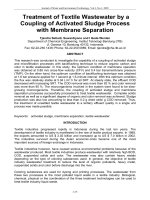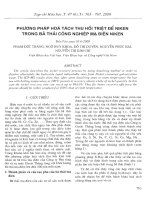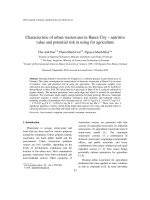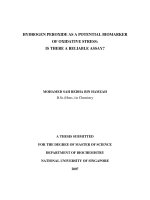Potential recovery of plastic waste
Bạn đang xem bản rút gọn của tài liệu. Xem và tải ngay bản đầy đủ của tài liệu tại đây (1.27 MB, 51 trang )
Potential Recovery of
Plastic Waste
May 6, 2014
Content
Overview
Techniques
• Mechanical Recycling
• Feedstock Recycling
• Energy Recovery
Environmental Potential
Economic Potential
Other methods of treating plastic waste
Part 1
Overview
Overview of plastic waste
What are plastics?
•
Polymers made from various
monomers
• Contains carbon, hydrogen,
oxygen, nitrogen, etc
Two main kinds
• Thermoplastics
• Thermosets
Plastic resin codes
Click to edit Master text styles
Second level
Third level
Fourth level
Fifth level
Plastic Industry
Plastic production from 1950-2012
Plastic consumption
Plastic waste in the world
Plastic waste in the Ocean
Click icon to add picture
Plastic waste imposes negative environmental externalities
Part 2
Techniques
i.
Mechanical Recycling
ii. Feedstock recycling
iii. Energy Recovery
Mechanical Recycling
(Source Burgdorf et al in 1997)
Plastic bottle recycle
Feedstock Recycling
• Depolymerization
• Hydrogenation
• Blast furnace
• Cracking
• Gasification
1. Depolymerisation
• Definition: The depolymerisation process is a technology for the
decomposition of mixed used plastics.
• End products: The oil (the so-called depolymerisate), HCl
• Application: Depolymerisation is used for the thermal conversion of used
plastic mixtures into oil which is utilized in existing refinery or energy
conversion plants.
Process
Advantages:
• The possibility of the use of
mixed used plastics containing
halogens.
• The possibility of the use of
heavy high chlorine factions
from the sorting of plastics.
• Insensitivity towards fluctuating
qualities of the material fed to
the system.
• Simple integration into existing
refinery and power conversion
plants.
2. Hydrogenation
• Definition: Hydrogenation of plastics is a potential alternative for breaking
down the polymer chain.
• End products: highly saturated products as fuels
• Process: using hydrogen with catalysts like palladium (Pt), nickel (Ni),
molybdenum (Mo) and iron (Fe), under high pressure during hydrogenation of
plastic.
3. Blast furnace
• Definition: The ‘feedstock recycling’ of plastics waste in
the metal blast furnace process provides a further option
for plastics at its end-of life.
• Application: Plastics convert iron ore to steel
• Process: plastic waste can roughly be described as a
hydrocarbon compound, is used as reducing agent.
4. Cracking
1. Hydrocracking
Polymers mixed
• 423–673 K
• 3–10 MPa
hydrogen
High quality
gasoline
catalyst
• Polyolefin
• PET
• polystyrene (PS)
• polyvinyl chloride
(PVC)
• mixed polymers
• …
• transition metals (e.g., Pt, Ni, Mo, Fe)
• acid solids (such as alumina,
amorphous silica–alumina, zeolites
and sulfated zirconia)
2. Thermal cracking (Pyrolysis)
• Degradation of the polymeric
materials by heating in the absence of
oxygen.
Four types of mechanisms:
• Conducted at 500- 800ºC
•
• Results in
carbonized char
volatile fraction:
- condensable hydrocarbon oil
- non-condensable high calorific
value gas.
• Chain-stripping
• End-chain scission or depolymerization
• Random-chain scission
• Cross-linking
2. Catalytic cracking
Introducing suitable catalysts could improve liquid hydrocarbons yield from
plastics pyrolysis.
There are two modes of catalyst usage:
•
liquid phase contact: the catalyst is contacted with melted plastics and acts mainly on the
partially degraded oligomers from the polymer chains.
•
vapor phase contact : the polymer is thermally degraded into hydrocarbon vapors which are
then contacted with the catalyst.
5. Gasification
The thermal conversion of any carbon-based material with a small amount of air or oxygen in a
heated chamber, into a mixture of combustible gases (hydrogen, carbon monoxide, carbon
dioxide and some trace compounds).
There are four different types of gasifiers:
• Updraft (counter-current flow gasifying agent and feedstock)
• Downdraft (co-current flow gasifying agent and feedstock)
• Crossdraft
• Plasma
Plasma gasification
Energy recovery
• MSWI (Municipal solid waste incineration) with energy recovery.
• Cement kiln
• Deriving fuel (petrol, diesel, LPG) from plastic.
1. MSWI with energy recovery
Slag
remain
at the
end of
kiln
Process
Plastic
waste
storage
Grid
kiln
Flue gas
and ash
Treated
Reuse in road
construction
cleaning
Flue gas cleaning
residues
NEUTREC
system
Disposal









